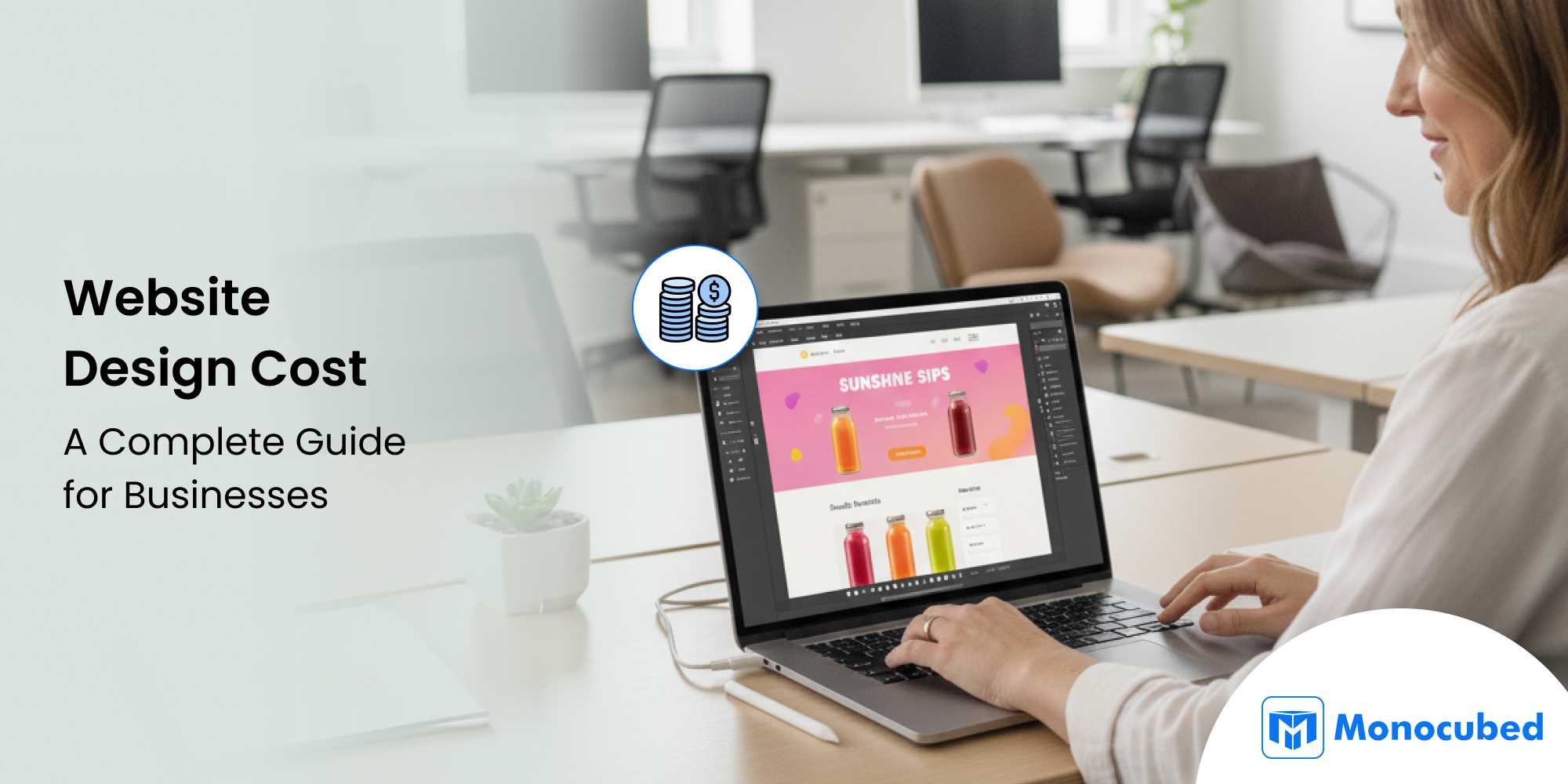Table of Contents
- How Much Does Website Design Cost?
- Which Factors Determine Website Design Cost? [4 Key Factors Explained]
- Key Elements That Make Up a Complete Website Design Package
- What are the Hidden Expenses in Your Website Design Budget? [6 Hidden Expenses]
- How to Choose the Right Website Design Partner for Your Business
- 4 Smart Strategies to Maximize ROI on Your Website Investment
- Get Your Website Designed With Monocubed
- Frequently Asked Questions
How much does it actually cost to design a website?
The average cost of website design ranges from stat
And now you wonder, what accounts for such a massive difference?
Real Truth: The website design cost depends on dozens of factors, including the type of website you need, the complexity of features, who builds it, and how much ongoing support you’ll require.
A landing page for a local bakery has completely different requirements (and costs) than an eCommerce platform processing thousands of daily transactions.
Monocubed offers custom web design services that have helped startups, mid-sized businesses, and enterprises navigate these website development cost decisions for over a decade. We’ve seen firsthand how the right web design and development investment drives measurable business growth, while cutting corners on quality leads to expensive rebuilds down the line.
In this web design pricing guide, you’ll discover:
- Realistic website design pricing for different business types and complexity levels
- The critical factors that drive costs up or down
- Detailed breakdowns of DIY builders, freelancers, and agency pricing
- Hidden ongoing costs most businesses forget to budget for
- How to choose the right development approach for your specific needs
- Smart strategies to maximize ROI on your website investment
Whether you’re a startup founder working with a tight budget or a growing company ready to invest in a professional web presence, this web design prices guide will help you make informed decisions about your professional website development cost.
Let’s start by understanding what website design actually includes and why pricing varies so dramatically across the industry.
How Much Does Website Design Cost?
The average cost of website design ranges from $500 to $10,000+, depending on your business needs, website complexity, and whether you hire web designers, freelancers, or one of the top website development agencies. Understanding the average price for website design at different investment levels helps you set realistic expectations and budget appropriately.
General pricing ranges and web design price list
Here’s a realistic breakdown of what businesses typically invest at different levels when considering the price of designing a website:
| Tier Name | Price Range | Deliverables |
|---|---|---|
| Starter | $500 – $2,000 | Template-based websites (WordPress, Wix, Squarespace), 5–10 pages, basic customization, mobile responsive, fundamental SEO setup |
| Growth | $2,000 – 5,000 | Semi-custom designs with branded elements, 10–25 pages, basic custom functionality, CRM/marketing integrations, professional copywriting |
| Enterprise | $10000+ | Fully custom or large-scale solutions with advanced functionality, complex integrations, scalability, enhanced security, and performance optimization |
Note: The above price ranges are indicative and may vary depending on project scope, design complexity, features, and business requirements.
While these ranges provide a helpful starting point, your actual investment will depend on several key factors. Understanding these drivers helps you anticipate web design costs more accurately and allocate your budget strategically.
Get Expert Guidance on Your Website Design Investment
Not sure where to start or what your website should cost? Our web design experts provide complimentary consultations to discuss your needs and budget. Provide you the custom website design cost.
Let’s explore the specific factors that directly impact your web design estimate.
Which Factors Determine Website Design Cost? [4 Key Factors Explained]
Understanding the specific elements that drive web design pricing helps you make informed decisions about where to invest and where to save. These factors directly impact the price of designing a website and the final professional website designer cost.
-
Website type and purpose
The fundamental purpose and type of website dramatically affects complexity and cost of website design:
- Informational websites: This type of websites serve as digital brochures for service businesses. These typically require 5-15 pages, contact forms, service descriptions, and basic SEO. Costs generally range from $500 to $3,000 for professional development.
- eCommerce websites: The online store introduces substantial complexity, including product catalogs, shopping carts, payment processing, inventory management, order tracking, and customer accounts. Basic eCommerce design starts around $2,000, while robust platforms can exceed $5000 depending on catalog size and custom features.
- Lead generation websites: This type of website design needs to focus on converting visitors into qualified leads through optimized landing pages, multi-step forms, CRM integrations, and conversion tracking. These sites require careful UX design and strategic page architecture, typically costing $5,000 to $10,000.
Beyond the fundamental purpose of your website, the level of complexity you choose significantly impacts both timeline and investment. Let’s break down what each complexity tier actually delivers.
-
Website design cost by complexity level
Beyond website type, the complexity of web design and functionality significantly impacts your investment. Whether you want to build a small business site, or design enterprise-grade sites, understanding these complexity tiers and website development pricing plans helps you match your business needs.
Website Tier Cost Range Inclusion Best Fit Simple $500 – $5,000 5–10 static pages, template-based design with light customization, basic contact forms, mobile responsive, fundamental on-page SEO, simple content management New businesses, solopreneurs, freelancers, and local service providers, testing market viability Medium Complexity $5,000 – $10,000 10–30 pages, semi-custom design with branded elements, custom forms/calculators, CRM/email marketing integrations, blog, basic eCommerce, member areas/gated content, strategic SEO Growing small businesses, B2B service companies, professional service firms, and eCommerce with focused products, strategic digital presence Advanced $10,000+ Fully custom designs, complex web apps or portals, extensive custom development, sophisticated user management, advanced eCommerce, multi-language, enterprise security, and comprehensive content structures Mid-market & enterprise companies, SaaS platforms, web apps, high-volume eCommerce, complex user needs, and companies requiring system integration Understanding complexity levels helps you scope your project, but an equally important decision is who will build your website. Your choice of development partner significantly affects both the cost of professional website design and the quality of the outcomes.
-
The design approach determines website design cost
Who builds your website dramatically impacts both cost and outcomes. When considering where to find a website designer and evaluating web design costs, each development approach offers distinct advantages and trade-offs worth understanding.
DIY website builders ($100 – $500/year)
- Platforms: Wix, Squarespace, WordPress.com
- What you get: Template-based designs, drag-and-drop editors, basic features, mobile responsiveness, hosting, support
- Limitations: Limited customization, template constraints, platform lock-in
- Best for: Solopreneurs, temporary projects, personal brands
Freelance website designers
- Investment: $2,000–$15,000
- What you get: Professional design expertise, personalized attention, flexible communication
- Limitations: Limited bandwidth, minimal post-launch support
- Best for: Small businesses with clear scope, budget-conscious projects
Professional web design agencies
- Investment: $10,000–$100,000+
- What you get: Full-time web design services, including strategy, project management, UX/UI, development, QA, content, SEO, post-launch support
- Advantages: Proven processes, diverse skills, backup resources
- Best for: Growing businesses, complex projects, companies lacking internal resources
In-house website design team ($100,000 – $300,000+/year)
- Investment: Salaries, benefits, software, equipment
- Team composition: Project manager, UX/UI designer, front-end/back-end developers, content, QA
- Advantages: Full control, immediate availability, alignment with company culture
- Best For: Enterprises with continuous development, proprietary platforms, complex systems
-
Website design cost breakdown by website type
Different types of websites serve different business objectives and require varying levels of investment. Understanding the cost breakdown for your specific website type helps set realistic web design budget expectations.
Website Type Average Cost Best For Landing Page Starts from $500 Product launches, lead magnets, webinar signups, event registrations, paid ad campaigns Small Business Website Starts from $2,000 Local businesses, professional practices, restaurants, retail stores, freelancers/solopreneurs Blog/Content Website Starts from $2,000 Publishers, media companies, personal brands, B2B content marketing, niche communities, affiliate marketers eCommerce Website Starts from $10,000+ Retail brands, B2B wholesalers, subscription services, digital product sellers, marketplaces Corporate/Enterprise Website Starts from $5,000+ Mid-market & enterprise corporations, complex B2B services, compliance-heavy industries, companies needing extensive content governance, sophisticated lead qualification Disclaimer: The cost ranges listed are general estimates and should not be considered as guaranteed pricing. Your actual website design price will depend on numerous factors. These figures serve as a starting point for budgeting purposes only.
These website design cost ranges reflect the varying scope and complexity required for different website types. But what exactly are you paying for when you invest in professional website design? Let’s break down the comprehensive services included in your investment.
Get Your Free Website Design Cost Estimate
Quick 5-minute questionnaire provides a realistic custom website design pricing range for your specific project needs and goals.
Key Elements That Make Up a Complete Website Design Package
Professional website design encompasses far more than visual aesthetics. Understanding the comprehensive scope of services included in your investment helps explain web design pricing variations and ensures you receive complete value.
-
Visual design and UX
Custom website design layouts aligned with your brand identity guide visitors intuitively toward desired actions. Professional web designers create wireframes, mockups, and prototypes that balance aesthetics with conversion optimization, ensuring your website not only looks professional but drives measurable business results.
-
Responsive development
Mobile-first coding ensures your website functions flawlessly across all devices and screen sizes. According to the data from Statcounter.com, 56.74 % of web traffic comes from mobile devices. This makes it essential for web designers to focus on designing sites that reach more audiences and get mobile-friendly experiences wherever they browse.
-
Content Management System (CMS)
CMS Platforms like WordPress, Webflow, or custom-built systems empower you to update content, add pages, and manage your website independently without coding knowledge. A well-implemented CMS reduces ongoing maintenance costs and gives you control over your digital presence.
-
Performance optimization
53% of mobile users abandon sites that take longer than 3 seconds to load. Professional web design services include image optimization, code minification, caching, and server configuration to ensure fast loading times and a smooth user experience.
-
SEO foundation
Proper site structure, clean code, meta tags, schema markup, and mobile-friendly design establish the technical SEO foundation that helps search engines discover, crawl, and rank your content. While ongoing SEO requires dedicated effort, professional development lays a solid foundation.
-
Quality assurance
Quality testing across browsers, devices, and screen sizes catches issues before launch. Professional developers verify forms work correctly, links function properly, checkout processes complete successfully, and security measures protect your business and customers.
Understanding this comprehensive scope helps explain website design pricing structure and where your investment creates lasting value. It demonstrates you’re building a digital asset that drives customer engagement, enhances user experience, and contributes to your business growth.
Want to Know What Our Website Design Process Entails
From project analysis to prototyping and design deployment, our website design professionals handle everything and also keep you up-to-date of each milestone.
While these core services represent your initial investment, smart businesses plan beyond the launch date. If you want to know website design services pricing, talk to the web development consultants who help you analyze your requirements, suggest the right solutions, and give a better quote.
What are the Hidden Expenses in Your Website Design Budget? [6 Hidden Expenses]
The sticker price for website design represents only your initial investment. Smart businesses budget for ongoing expenses that ensure their websites remain secure, fast, and effective over time.
-
Domain registration and renewal
Your domain name (yourcompany.com) requires annual registration fees, typically $10-50 per year depending on the domain extension (.com, .org, .co, etc.). Premium or competitive domain names can cost hundreds or thousands of dollars annually if you purchase from domain marketplaces.
Budget recommendation: $15-100/year for standard domains, $500-5,000+ for premium domains purchased from secondary markets.
-
Web hosting costs
Hosting provides the server infrastructure where your website files live and serve to visitors.
Hosting Type Annual Cost Overview / Best For Shared Hosting $50 – $200 Multiple websites share server resources; low-cost options for small sites with modest traffic; limited performance and security. VPS Hosting $200 – $1,000 Virtual Private Servers with dedicated resources; better performance and security; ideal for growing businesses. Managed WordPress Hosting $300 – $2,000 Optimized for WordPress with automatic updates, enhanced security, and daily backups; great for serious business websites. Cloud Hosting $500 – $5,000+ Scalable hosting adjusting resources based on traffic; needed for high-traffic sites or complex applications. Note: Hosting costs are estimates and can vary significantly based on your specific traffic volume, storage needs, bandwidth requirements, and hosting provider. Always review multiple hosting providers and compare features alongside pricing for the best value.
-
SSL certificates and security
SSL certificates encrypt data between your website and visitors, essential for both security and SEO rankings. Most hosting providers now include basic SSL certificates, but premium options offer enhanced validation and security features.
Budget recommendation: $0-200/year. Basic certificates are often free through hosting providers, while extended validation certificates cost $100-200/year.
-
Website maintenance and updates
Websites require ongoing maintenance to remain secure, functional, and competitive:
- Software updates: Content management systems, themes, and plugins release regular updates addressing security vulnerabilities and adding features. Neglecting updates creates security risks and compatibility issues.
- Security monitoring: Regular security scans, malware removal, and security hardening prevent hacks and data breaches that damage reputation and operations.
- Backup management: Regular automated backups ensure you can recover from server failures, hacking attempts, or accidental deletions.
- Performance optimization: Ongoing monitoring and optimization maintain fast loading speeds as content grows and technologies evolve.
Budget recommendation: $1,000-5,000/year for professional maintenance, or $100-300/month for comprehensive agency retainers.
-
Content updates and revisions
Even with CMS access, businesses often need professional help for:
- Regular content updates to keep information current and relevant
- Blog post creation to maintain content marketing momentum
- Image and graphic updates to refresh visual appeal
- New page creation as services or products expand
Budget recommendation: $500-3,000/year for occasional updates, or $1,000-5,000+/year for businesses actively growing and optimizing their web presence.
-
Search engine optimization (SEO)
Initial website design includes basic SEO foundation, but ongoing SEO requires dedicated effort:
- Technical SEO to ensure crawlability and site health
- Content optimization targeting valuable search terms
- Link building to develop authority and rankings
- Local SEO for businesses serving geographic markets
- Performance tracking and reporting to measure results
Budget recommendation: $500-2,000/month for professional SEO services, though competitive industries may require $3,000-10,000/month for comprehensive strategies.
Now that you understand both initial and ongoing costs, the question becomes: who should build your website? With options ranging from DIY builders to enterprise web design agencies, making the right choice requires careful evaluation of your specific needs and resources.
How to Choose the Right Website Design Partner for Your Business
Selecting the right website design agency or professional web designers requires an honest assessment of your needs, resources, and objectives. These key points help you learn “how to hire web designers” or the professional web design and development agency that align with your workflows and provides smooth collaboration.
-
Questions to ask before deciding
Start your decision process by considering these fundamental questions that will impact your website design price and approach:
- What are your primary website objectives?
- What’s your realistic timeline?
- What’s your actual budget?
- Do you have internal resources?
- How technical is your team?
- How important is your website to business success?
-
Matching business stage to investment level
Your business maturity typically correlates with appropriate website investment:
- Startup/validation stage ($500-3,000): When testing market fit or just starting out, template-based solutions or simple freelancer-built sites provide adequate presence without overcommitting resources. Focus on a minimum viable presence to validate your concept.
- Growth stage ($3,000-20,000): Established businesses with proven models benefit from professional web design that differentiates brand positioning and optimizes conversion. This investment pays returns through improved lead quality and quantity.
- Scaling stage ($20,000-50,000): Companies scaling operations need sophisticated functionality, system integrations, and strategic optimization. Your website becomes a business infrastructure requiring significant investment.
- Enterprise stage ($50,000+): Large organizations require custom platforms with advanced functionality, security, and compliance features. Website investment represents competitive differentiation and must scale with organizational complexity.
-
Red flags to avoid
Watch for warning signs when evaluating development options:
- Unrealistically low pricing: If quotes seem too good to be true, they probably are. Experienced professionals charge rates reflecting their expertise. Rock-bottom prices typically mean inexperienced developers, overseas outsourcing with communication challenges, or hidden costs emerging later.
- Vague proposals: Professional developers provide detailed proposals specifying deliverables, timelines, revision policies, and payment terms. Vague proposals (“we’ll build you a website”) leave room for scope creep and disappointment.
- No portfolio or references: Insist on seeing previous work and talking to past clients. Developers without portfolios or unwilling to provide references raise red flags about quality and reliability.
- Pressure tactics: Legitimate professionals don’t pressure you into immediate decisions. High-pressure sales tactics often signal more concern with closing deals than delivering results.
- Ownership questions: Ensure you own your website, domain, hosting access, and all creative assets after project completion. Some developers maintain ownership, creating ongoing dependency and eventual migration costs.
Beyond selecting the right development partner, how you approach the project itself significantly impacts your return on investment. These four strategies help you maximize value regardless of your budget tier.
4 Smart Strategies to Maximize ROI on Your Website Investment
Regardless of your web design budget tier, strategic approaches help you get maximum value from your website design investment and ensure your web design pricing delivers measurable results.
-
Prioritize features strategically
Focus on essential features that directly support your business goals like lead generation, sales, or showcasing your value. Add advanced functionality later based on user feedback and analytics to invest where it truly matters.
Start with core features that serve your primary business objective. If lead generation is your goal, perfect your contact forms, CTA placement, and conversion paths before adding blog functionality or member portals. Launch faster with essentials, then iterate based on actual user behavior rather than assumptions.
-
Plan for scalability
Choose flexible website development platforms like WordPress or Webflow and build clean, organized foundations. Start with reliable hosting to avoid costly migrations and support growth smoothly.
Scalable architecture means your website can grow without complete rebuilds. Invest in quality hosting that can scale with traffic increases. Structure your content and data logically so adding products, services, or features doesn’t require fundamental changes.
-
Focus on conversion optimization
Design a website for user experience, clear messaging, and measurable results. Use analytics from day one to track performance and guide improvements that boost conversions.
Conversion rate improvements deliver immediate ROI without additional traffic investment. Test different headlines, CTA placements, form lengths, and page layouts.
-
Negotiate smart contracts
Ensure proposals clearly define scope, timelines, revisions, payments, ownership, and post-launch support. Include training so your team can manage the website independently.
Define exactly what’s included and what costs extra. Clarify revision limits to prevent endless back-and-forth. Establish clear ownership of code, design files, and content. Include training sessions so your team can make basic updates without ongoing developer dependency.
Implementing these strategies requires experience, technical expertise, and strategic thinking that separate successful website projects from costly disappointments.
Get Your Website Designed With Monocubed
Website design cost ultimately reflects the value you place on your digital presence and the business results you expect it to drive. From startups working with tight budgets to enterprises requiring sophisticated platforms, the right investment level matches your business stage, objectives, and growth trajectory.
At Monocubed, we’ve spent over a decade helping businesses make the right digital decisions through our website development and design expertise. From high-converting landing pages to enterprise-grade platforms handling millions in transactions, we design and build with precision, purpose, and performance in mind.
Our in-house website design team blends creativity with tools like Figma, Adobe XD, and enhanced with AI-assisted design workflows for faster prototyping and data-backed UI decisions. Apart from this, there are other reasons to choose Monocubed as the best website design firm for professional services.
Why businesses choose Monocubed for website design:
- 5+ years of web design and development experience
- Transparent pricing with clearly defined scope
- 200+ successful web solutions delivered
- Full-stack development and integration expertise
- AI-driven workflows enabling faster project delivery
- Long-term partnerships focused on client growth
Whether you want a website redesign solution or a fully custom design of your site, the next step is understanding your specific needs and options. We offer complimentary consultations to discuss your objectives, current situation, and potential approaches at various budget levels.
Need a Web Design That Works Within Your Budget?
Discover a custom web design strategy crafted for your business, whether startup or enterprise and see how the right investment drives real results.
Frequently Asked Questions
-
What’s the difference between a $2,000 website and a $20,000 website design?
A $2,000 website design typically uses templates with minimal customization, includes basic features, and involves limited strategic input. A $20,000 website design features a fully custom design aligned with brand strategy, sophisticated functionality, extensive user experience optimization, integration with business systems, and a comprehensive SEO foundation and content strategy.
The price difference reflects design customization, web design quality, strategic thinking, and enhancements of the design elements before launching the website.
-
Should I use a website builder or hire a professional designer?
Use website builders if you have an extremely limited budget (under $1,000), need a simple site with basic features, have time to invest in learning and building, and don’t require custom functionality. Hire professional designers if your website directly impacts revenue, you need custom functionality or integrations, you lack time for DIY building, or you want strategic guidance and optimization for business results.
-
How much does it cost to hire a web designer?
Freelance web designers typically charge $50-150/hour or $2,000-15,000 per project. Professional agencies charge $100-250/hour or $10,000-100,000+ for comprehensive projects. The cost to hire a web designer varies widely based on their experience level and project scope.
Geographic location significantly impacts rates: web designers in major US cities charge $60-80/hour while those in smaller markets or internationally charge $20-60/hour. For best value, focus on the website designer’s portfolio quality and relevant experience rather than just hourly rates.
If you want to work with experts, Monocubed has a team of web designers with expertise required for designing modern websites to meet user expectations.
-
What is the average cost of website design for a small business?
The average small business website design cost typically ranges between $2,000 to $10,000, depending on your goals, features, and who you hire. A simple brochure-style site with basic pages may cost around $500–$2,500, while a more customized, CMS-based site like WordPress can range from $3,000–$10,000 or more.
These are the average estimate of the website design cost, which varies based on project requirements. If you are a small business, consider taking help from a website design company like Monocubed which offers cost-effective design solutions tailored to project needs and goals.
-
How much should a website redesign cost?
The cost of a website redesign typically ranges from $2,000 to $20,000, depending on your goals, design complexity, and who you hire. A basic refresh for a small business site may cost $2,000–$7,000, while a complete redesign with custom layouts, new features, or eCommerce functionality can cost $20,000 or more.
If you want a modern, high-performing website aligned with your brand and SEO goals, it’s best to hire a professional web design agency to ensure quality results and long-term ROI.
-
How long does professional website design typically take?
Simple template-based websites take 2-4 weeks, mid-range custom sites require 6-12 weeks, and complex custom platforms need 3-9 months. Timeline factors include project scope and complexity, content and asset readiness, number of stakeholders and approval processes, developer availability and workload, and your responsiveness to feedback requests.
Monocubed’s team of web designers are well-versed with current design tools and technologies and AI capabilities. This specialized expertise helps them to deliver the solution faster time-to-market.
-
Can I start with a basic website and add features later?
Yes, this phased approach is often a smart strategy. Launch with essential features serving primary business objectives, then add functionality based on user feedback and analytics data. Ensure your initial build uses scalable architecture and flexible platforms that accommodate expansion without complete rebuilds.
-
How much does website maintenance cost annually?
Expect to budget $1,000-5,000 annually for professional website maintenance, or $100-300/month for comprehensive agency retainers. This covers software updates, security monitoring, regular backups, performance optimization, minor content updates, and technical support. Simple sites on the lower end, eCommerce or complex sites on the higher end.
 By Yuvrajsinh Vaghela
By Yuvrajsinh Vaghela



